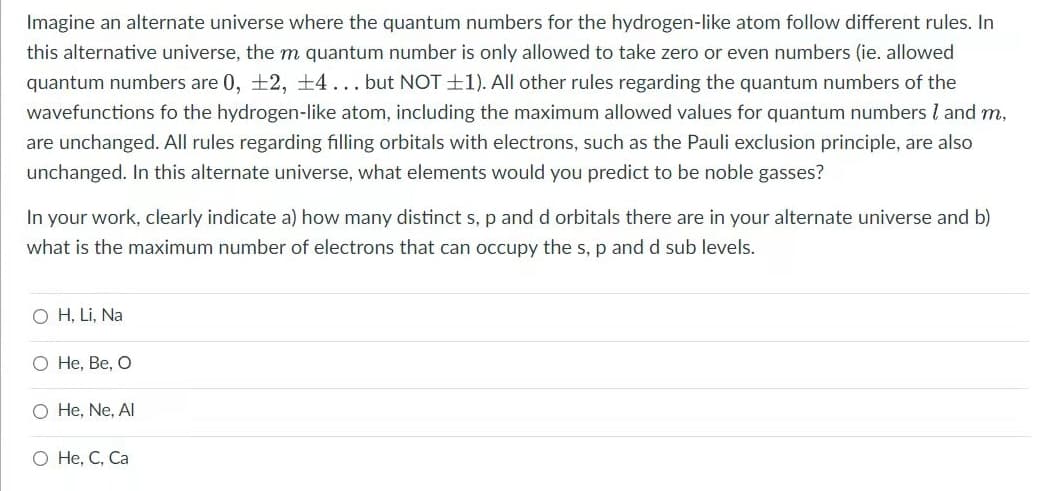Imagine an alternate universe where the quantum numbers for the hydrogen-like atom follow different rules. In this alternative universe, the m quantum number is only allowed to take zero or even numbers (ie. allowed quantum numbers are 0, +2, ±4... but NOT ±1). All other rules regarding the quantum numbers of the wavefunctions fo the hydrogen-like atom, including the maximum allowed values for quantum numbers l and m, are unchanged. All rules regarding filling orbitals with electrons, such as the Pauli exclusion principle, are also unchanged. In this alternate universe, what elements would you predict to be noble gasses? In your work, clearly indicate a) how many distinct s, p and d orbitals there are in your alternate universe and b) what is the maximum number of electrons that can occupy the s, p and d sub levels. O H, Li, Na О Не, Ве, О O He, Ne, Al О Не, С, Са
Imagine an alternate universe where the quantum numbers for the hydrogen-like atom follow different rules. In this alternative universe, the m quantum number is only allowed to take zero or even numbers (ie. allowed quantum numbers are 0, +2, ±4... but NOT ±1). All other rules regarding the quantum numbers of the wavefunctions fo the hydrogen-like atom, including the maximum allowed values for quantum numbers l and m, are unchanged. All rules regarding filling orbitals with electrons, such as the Pauli exclusion principle, are also unchanged. In this alternate universe, what elements would you predict to be noble gasses? In your work, clearly indicate a) how many distinct s, p and d orbitals there are in your alternate universe and b) what is the maximum number of electrons that can occupy the s, p and d sub levels. O H, Li, Na О Не, Ве, О O He, Ne, Al О Не, С, Са
Principles of Modern Chemistry
8th Edition
ISBN:9781305079113
Author:David W. Oxtoby, H. Pat Gillis, Laurie J. Butler
Publisher:David W. Oxtoby, H. Pat Gillis, Laurie J. Butler
Chapter4: Introduction To Quantum Mechanics
Section: Chapter Questions
Problem 59AP
Related questions
Question

Transcribed Image Text:Imagine an alternate universe where the quantum numbers for the hydrogen-like atom follow different rules. In
this alternative universe, the m quantum number is only allowed to take zero or even numbers (ie. allowed
quantum numbers are 0, +2, +4... but NOT +1). All other rules regarding the quantum numbers of the
wavefunctions fo the hydrogen-like atom, including the maximum allowed values for quantum numbers I and m,
are unchanged. All rules regarding filling orbitals with electrons, such as the Pauli exclusion principle, are also
unchanged. In this alternate universe, what elements would you predict to be noble gasses?
In your work, clearly indicate a) how many distinct s, p and d orbitals there are in your alternate universe and b)
what is the maximum number of electrons that can occupy the s, p and d sub levels.
O H, Li, Na
Не, Ве, О
O He, Ne, Al
О Н, С, Са
Expert Solution
This question has been solved!
Explore an expertly crafted, step-by-step solution for a thorough understanding of key concepts.
This is a popular solution!
Trending now
This is a popular solution!
Step by step
Solved in 3 steps with 2 images

Knowledge Booster
Learn more about
Need a deep-dive on the concept behind this application? Look no further. Learn more about this topic, chemistry and related others by exploring similar questions and additional content below.Recommended textbooks for you

Principles of Modern Chemistry
Chemistry
ISBN:
9781305079113
Author:
David W. Oxtoby, H. Pat Gillis, Laurie J. Butler
Publisher:
Cengage Learning

Chemistry: Principles and Reactions
Chemistry
ISBN:
9781305079373
Author:
William L. Masterton, Cecile N. Hurley
Publisher:
Cengage Learning

Physical Chemistry
Chemistry
ISBN:
9781133958437
Author:
Ball, David W. (david Warren), BAER, Tomas
Publisher:
Wadsworth Cengage Learning,

Principles of Modern Chemistry
Chemistry
ISBN:
9781305079113
Author:
David W. Oxtoby, H. Pat Gillis, Laurie J. Butler
Publisher:
Cengage Learning

Chemistry: Principles and Reactions
Chemistry
ISBN:
9781305079373
Author:
William L. Masterton, Cecile N. Hurley
Publisher:
Cengage Learning

Physical Chemistry
Chemistry
ISBN:
9781133958437
Author:
Ball, David W. (david Warren), BAER, Tomas
Publisher:
Wadsworth Cengage Learning,

Chemistry: Principles and Practice
Chemistry
ISBN:
9780534420123
Author:
Daniel L. Reger, Scott R. Goode, David W. Ball, Edward Mercer
Publisher:
Cengage Learning

Chemistry: An Atoms First Approach
Chemistry
ISBN:
9781305079243
Author:
Steven S. Zumdahl, Susan A. Zumdahl
Publisher:
Cengage Learning
